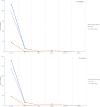The first complete chloroplast genome sequences in Resedaceae: Genome structure and comparative analysis
- PMID: 34870493
- PMCID: PMC10450604
- DOI: 10.1177/00368504211059973
The first complete chloroplast genome sequences in Resedaceae: Genome structure and comparative analysis
Abstract
Caylusea hexagyna and Ochradenus baccatus are two species in the Resedaceae family. In this study, we analysed the complete plastid genomes of these two species using high-throughput sequencing technology and compared their genomic data. The length of the plastid genome of C. hexagyna was 154,390 bp while that of O. baccatus was 153,380 bp. The lengths of the inverted repeats (IR) regions were 26,526 bp and 26,558 bp, those of the large single copy (LSC) regions were 83,870 bp and 83,023 bp; and those of the small single copy (SSC) regions were 17,468 bp and 17,241 bp in C. hexagyna and O. baccatus, respectively. Both genomes consisted of 113 genes: 79 protein-coding genes, 30 tRNA genes and 4 rRNA genes. Repeat analysis showed that the plastid genome included all types of repeats, with more frequent occurrences of palindromic sequences. Comparative studies of SSR markers showed that there were 256 markers in C. hexagyna and 255 in O. baccatus; the majority of the SSRs in these plastid genomes were mononucleotide repeats (A/T). All the clusters in the phylogenetic tree had high support. This study reported the first complete plastid genomes of the genera Caylusea and Ochradenus and the first for the Resedaceae family.
Keywords: Caylusea hexagyna; Ochradenus baccatus; Resedaceae; chloroplast genome (cp); genetics; phylogenetic relationships.
Conflict of interest statement
The author(s) declared no potential conflicts of interest with respect to the research, authorship, and/or publication of this article.
Figures








References
-
- Christenhusz MJM, Byng JW. The number of known plants species in the world and its annual increase. Phytotaxa 2016; 261: 201–217.
-
- Willis JC. A dictionary of the flowering plants & ferns, 7th ed. Cambridge, UK: Cambridge University Press, 1973.
-
- Mabberley DI. The plant book. Cambridge, UK: Cambridge University Press, 1987.
-
- Engler A, Prantle K. Die naturlichen pflanzen familien, vol. 3 (4 & 5). Leipzig: Engelmann, 1897.
-
- Hutchinson J. Evolution and phylogeny of flowering plants. Dicotyledons: facts and theory with over 550 illustrations and maps by the author. London, New York: Academic Press, 1969.
MeSH terms
LinkOut - more resources
Full Text Sources
Miscellaneous

